Population and Landslide Risk Evolution in Long Time Series: Case Study of the Valencian Community (1920–2021)
Abstract
1. Introduction
2. Methodology
2.1. General Frameworks
2.2. Status and Trend Indices
3. Case Study: Valencian Community
3.1. Data Used
3.1.1. Susceptibility Mapping
3.1.2. Population
3.1.3. Cadastre
3.2. Method Implementation
3.2.1. Calculation of Affected Population
3.2.2. Obtaining Indices
4. Results
5. Discussion
5.1. Correlated Variables
5.2. Cluster Analysis
6. Conclusions
Author Contributions
Funding
Data Availability Statement
Conflicts of Interest
References
- Chen, C.W.; Tung, Y.S.; Chu, F.Y.; Li, H.C.; Chen, Y.M. Assessing landslide risks across varied land-use types in the face of climate change. Landslides 2024, 1–15. [Google Scholar] [CrossRef]
- Gariano, S.L.; Guzzetti, F. Landslides in a changing climate. Earth-Sci. Rev. 2016, 162, 227–252. [Google Scholar] [CrossRef]
- Haque, U.; Da Silva, P.F.; Devoli, G.; Pilz, J.; Zhao, B.; Khaloua, A.; Wilopo, W.; Andersen, P.; Lu, P.; Lee, J.; et al. The human cost of global warming: Deadly landslides and their triggers (1995–2014). Sci. Total Environ. 2019, 682, 673–684. [Google Scholar] [CrossRef]
- Moore, R.; McInnes, R. The impacts of landslides on global society: Planning for change. Landslides Eng. Slopes. Exp. Theory Pract. 2016, 3, 1461–1468. [Google Scholar] [CrossRef]
- Fuchs, S. Susceptibility versus resilience to mountain hazards in Austria—Paradigms of vulnerability revisited. Nat. Hazards Earth Syst. Sci. 2009, 9, 337–352. [Google Scholar] [CrossRef]
- Kienberger, S.; Lang, S.; Zeil, P. Spatial vulnerability units—Expert-based spatial modelling of socio-economic vulnerability in the Salzach catchment, Austria. Nat. Hazards Earth Syst. Sci. 2009, 9, 767–778. [Google Scholar] [CrossRef]
- Papathoma-Köhle, M.; Kappes, M.; Keiler, M.; Glade, T. Physical vulnerability assessment for alpine hazards: State of the art and future needs. Nat. Hazards J. Int. Soc. Prev. Mitig. Nat. Hazards 2011, 58, 645–680. [Google Scholar] [CrossRef]
- Kappes, M.S.; Papathoma-Köhle, M.; Keiler, M. Assessing physical vulnerability for multi-hazards using an indicator-based methodology. Appl. Geogr. 2012, 32, 577–590. [Google Scholar] [CrossRef]
- Fuchs, S.; Kuhlicke, C.; Meyer, V. Editorial for the special issue: Vulnerability to natural hazards-the challenge of integration. Nat. Hazards 2011, 58, 609–619. [Google Scholar] [CrossRef]
- Karagiorgos, K.; Thaler, T.; Hübl, J.; Maris, F.; Fuchs, S. Multi-vulnerability analysis for flash flood risk management. Nat. Hazards 2016, 82, 63–87. [Google Scholar] [CrossRef]
- Michael-Leiba, M.; Baynes, F.; Scott, G.; Granger, K. Regional landslide risk to the Cairns community. Nat. Hazards 2003, 302, 233–249. [Google Scholar] [CrossRef]
- Keiler, M. Development of the damage potential resulting from avalanche risk in the period 1950-2000, case study Galtür. Nat. Hazards Earth Syst. Sci. 2004, 4, 249–256. [Google Scholar] [CrossRef]
- Promper, C.; Glade, T. Multilayer-exposure maps as a basis for a regional vulnerability assessment for landslides: Applied in Waidhofen/Ybbs, Austria. Nat. Hazards 2016, 82, 111–127. [Google Scholar] [CrossRef]
- Fuchs, S.; Keiler, M.; Zischg, A. A spatiotemporal multi-hazard exposure assessment based on property data. Nat. Hazards Earth Syst. Sci. 2015, 15, 2127–2142. [Google Scholar] [CrossRef]
- Guillard-Goncalves, C.; Zezere, J.L.; Pereira, S.; Garcia, R.A.C. Assessment of physical vulnerability of buildings and analysis of landslide risk at the municipal scale: Application to the Loures municipality, Portugal. Nat. Hazards Earth Syst. Sci. 2016, 16, 311–331. [Google Scholar] [CrossRef]
- Petrucci, O.; Gullà, G. A simplified method for assessing landslide damage indices. Nat. Hazards J. Int. Soc. Prev. Mitig. Nat. Hazards 2010, 52, 539–560. [Google Scholar] [CrossRef]
- Promper, C.; Gassner, C.; Glade, T. Spatiotemporal patterns of landslide exposure—A step within future landslide risk analysis on a regional scale applied in Waidhofen/Ybbs Austria. Int. J. Disaster Risk Reduct. 2015, 12, 25–33. [Google Scholar] [CrossRef]
- Silva, M.; Pereira, S. Assessment of physical vulnerability and potential losses of buildings due to shallow slides. Nat. Hazards 2014, 72, 1029–1050. [Google Scholar] [CrossRef]
- Uzielli, M.; Catani, F.; Tofani, V.; Casagli, N. Risk analysis for the Ancona landslide—II: Estimation of risk to buildings. Landslides 2015, 12, 83–100. [Google Scholar] [CrossRef]
- Uzielli, M.; Catani, F.; Tofani, V.; Casagli, N. Risk analysis for the Ancona landslide—I: Characterization of landslide kinematics. Landslides 2015, 12, 69–82. [Google Scholar] [CrossRef]
- Winter, M.G.; Smith, J.T.; Fotopoulou, S.; Pitilakis, K.; Mavrouli, O.; Corominas, J.; Argyroudis, S. An expert judgement approach to determining the physical vulnerability of roads to debris flow. Bull. Eng. Geol. Environ. 2014, 73, 291–305. [Google Scholar] [CrossRef]
- De Oliveira Mendes, J.M. Social vulnerability indexes as planning tools: Beyond the preparedness paradigm. J. Risk Res. 2009, 12, 43–58. [Google Scholar] [CrossRef]
- Wood, N.J.; Burton, C.G.; Cutter, S.L. Community variations in social vulnerability to Cascadia-related tsunamis in the U.S. Pacific Northwest. Nat. Hazards J. Int. Soc. Prev. Mitig. Nat. Hazards 2010, 52, 369–389. [Google Scholar] [CrossRef]
- Di Napoli, M.; Miele, P.; Guerriero, L.; Corona, M.A.; Calcaterra, D.; Ramondini, M.; Sellers, C.; Martire, D.D. Multitemporal relative landslide exposure and risk analysis for the sustainable development of rapidly growing cities. Landslides 2023, 20, 1781–1795. [Google Scholar] [CrossRef]
- Bukhari, M.H.; da Silva, P.F.; Pilz, J.; Istanbulluoglu, E.; Görüm, T.; Lee, J.; Karamehic-Muratovic, A.; Urmi, T.; Soltani, A.; Wilopo, W.; et al. Community perceptions of landslide risk and susceptibility: A multi-country study. Landslides 2023, 20, 1321–1334. [Google Scholar] [CrossRef]
- Guzzetti, F. Landslide fatalities and the evaluation of landslide risk in Italy. Eng. Geol. 2000, 58, 89–107. [Google Scholar] [CrossRef]
- Vranken, L.; Van Turnhout, P.; Van Den Eeckhaut, M.; Vandekerckhove, L.; Poesen, J. Economic valuation of landslide damage in hilly regions: A case study from Flanders, Belgium. Sci. Total Environ. 2013, 447, 323–336. [Google Scholar] [CrossRef]
- Fidan, S.; Tanyaş, H.; Akbaş, A.; Lombardo, L.; Petley, D.N.; Görüm, T. Understanding fatal landslides at global scales: A summary of topographic, climatic, and anthropogenic perspectives. Nat. Hazards 2024, 120, 6437–6455. [Google Scholar] [CrossRef]
- Guzzetti, F.; Stark, C.P.; Salvati, P. Evaluation of flood and landslide risk to the population of Italy. Environ. Manag. 2005, 36, 15–36. [Google Scholar] [CrossRef]
- Gariano, S.L.; Petrucci, O.; Guzzetti, F. Changes in the occurrence of rainfall-induced landslides in Calabria, southern Italy, in the 20th century. Nat. Hazards Earth Syst. Sci. 2015, 15, 2313–2330. [Google Scholar] [CrossRef]
- Zêzere, J.L.; Oliveira, S.C.; Garcia, R.A.C.; Reis, E. Landslide risk analysis in the area North of Lisbon (Portugal): Evaluation of direct and indirect costs resulting from a motorway disruption by slope movements. Landslides 2007, 4, 123–136. [Google Scholar] [CrossRef]
- Zêzere, J.L.; Garcia, R.A.C.; Oliveira, S.C.; Reis, E. Probabilistic landslide risk analysis considering direct costs in the area north of Lisbon (Portugal). Geomorphology 2008, 94, 467–495. [Google Scholar] [CrossRef]
- Remondo, J.; Bonachea, J.; Cendrero, A. Quantitative landslide risk assessment and mapping on the basis of recent occurrences. Geomorphology 2008, 94, 496–507. [Google Scholar] [CrossRef]
- Corominas, J.; Van Westen, C.; Frattini, P.; Cascini, L.; Malet, J.-P.; Fotopoulou, S.; Catani, F.; Van Den Eeckhaut, M.; Mavrouli, O.; Agliardi, F.; et al. Recommendations for the quantitative analysis of landslide risk. Bull. Eng. Geol. Environ. 2014, 73, 209–263. [Google Scholar] [CrossRef]
- Schwendtner, B.; Papathoma-Köhle, M.; Glade, T. Risk evolution: How can changes in the built environment influence the potential loss of natural hazards? Nat. Hazards Earth Syst. Sci. 2013, 13, 2195–2207. [Google Scholar] [CrossRef]
- Su, M.D.; Lin, M.C.; Hsieh, H.I.; Tsai, B.W.; Lin, C.H. Multi-layer multi-class dasymetric mapping to estimate population distribution. Sci. Total Environ. 2010, 408, 4807–4816. [Google Scholar] [CrossRef]
- Freire, S.; Aubrecht, C. Integrating population dynamics into mapping human exposure to seismic hazard. Nat. Hazards Earth Syst. Sci. 2012, 12, 3533–3543. [Google Scholar] [CrossRef]
- Aubrecht, C.; Özceylan, D.; Steinnocher, K.; Freire, S. Multi-level geospatial modeling of human exposure patterns and vulnerability indicators. Nat. Hazards 2013, 68, 147–163. [Google Scholar] [CrossRef]
- Opdyke, A.; Fatima, K. Comparing the suitability of global gridded population datasets for local landslide risk assessments. Nat. Hazards 2024, 120, 2415–2432. [Google Scholar] [CrossRef]
- Bhaduri, B.L.; Bright, E.A.; Dobson, J.E. LandScan: Locating People is What Matters. Geoinfomatics 2002, 5(2), 34–37. [Google Scholar]
- Wen, H.; Huang, J.; Qian, L.; Li, Z.; Zhang, Y.; Zhang, J. The spatial-temporal evolution patterns of landslide-oriented resilience in mountainous city: A case study of Chongqing, China. J. Environ. Manag. 2024, 370, 122963. [Google Scholar] [CrossRef] [PubMed]
- Meerow, S.; Newell, J.P.; Stults, M. Defining urban resilience: A review. Landsc. Urban Plan. 2016, 147, 38–49. [Google Scholar] [CrossRef]
- Tian, N.; Lan, H. The indispensable role of resilience in rational landslide risk management for social sustainability. Geogr. Sustain. 2023, 4, 70–83. [Google Scholar] [CrossRef]
- Garcia, R.A.C.; Oliveira, S.C.; Zêzere, J.L. Assessing population exposure for landslide risk analysis using dasymetric cartography. Nat. Hazards Earth Syst. Sci. 2016, 16, 2769–2782. [Google Scholar] [CrossRef]
- Goerlich, F.J. HIPGDAC-ES: Historical population grid data compilation for Spain (1900–2021). Sci. Data 2025, 12, 280. [Google Scholar] [CrossRef]
- Fell, R.; Corominas, J.; Bonnard, C.; Cascini, L.; Leroi, E.; Savage, W.Z. Guidelines for landslide susceptibility, hazard and risk zoning for land use planning. Eng. Geol. 2008, 102, 85–98. [Google Scholar] [CrossRef]
- Günther, A.; Van Den Eeckhaut, M.; Malet, J.P.; Reichenbach, P.; Hervás, J. Climate-physiographically differentiated Pan-European landslide susceptibility assessment using spatial multi-criteria evaluation and transnational landslide information. Geomorphology 2014, 224, 69–85. [Google Scholar] [CrossRef]
- Cantarino, I.; Carrion, M.A.; Goerlich, F.; Ibañez, V.M. A ROC analysis-based classification method for landslide susceptibility maps. Landslides 2019, 16, 265–282. [Google Scholar] [CrossRef]
- Cantarino, M.; Carrion, A.; Martínez-Ibáñez, V.; Gielen, E. Improving Landslide Susceptibility Assessment through Frequency Ratio and Classification Methods—Case Study of Valencia Region (Spain). Appl. Sci. 2023, 13, 5146. [Google Scholar] [CrossRef]
- European Commission. GHS-POP R2023A—GHS Population Grid Multitemporal. Joint Research Centre Data Catalogue. Available online: https://data.jrc.ec.europa.eu/dataset/2ff68a52-5b5b-4a22-8f40-c41da8332cfe (accessed on 12 March 2025).
- Uhl, J.H.; Royé, D.; Burghardt, K.; Vázquez, J.A.A.; Sanchiz, M.B.; Leyk, S. HISDAC-ES: Historical settlement data compilation for Spain (1900–2020). Earth Syst. Sci. Data 2023, 15, 4713–4747. [Google Scholar] [CrossRef]
- Huang, J.; Lu, X.X.; Sellers, J.M. A global comparative analysis of urban form: Applying spatial metrics and remote sensing. Landsc. Urban Plan. 2007, 82, 184–197. [Google Scholar] [CrossRef]
- Stewart, T.J.; Janssen, R. A multiobjective GIS-based land use planning algorithm. Comput. Environ. Urban Syst. 2014, 46, 25–34. [Google Scholar] [CrossRef]
- Gisbert, F.J.G.; Martí, I.C.; Gielen, E. Clustering cities through urban metrics analysis. J. Urban Des. 2017, 22, 689–708. [Google Scholar] [CrossRef]
- Kuiper, F.K.; Fisher, L. 391: A Monte Carlo Comparison of Six Clustering Procedures. Biometrics 1975, 31, 777. [Google Scholar] [CrossRef]
- Sarstedt, M.; Mooi, E. Cluster analysis. In A Concise Guide to Market Research; Springer: Berlin/Heidelberg, Germany, 2014; pp. 273–324. [Google Scholar] [CrossRef]
- Cantarino, I.; Carrion, M.A.; Palencia-Jimenez, J.S.; Martínez-Ibáñez, V. Landslide risk management analysis on expansive residential areas-case study of la Marina (Alicante, Spain). Nat. Hazards Earth Syst. Sci. 2021, 21, 1847–1866. [Google Scholar] [CrossRef]


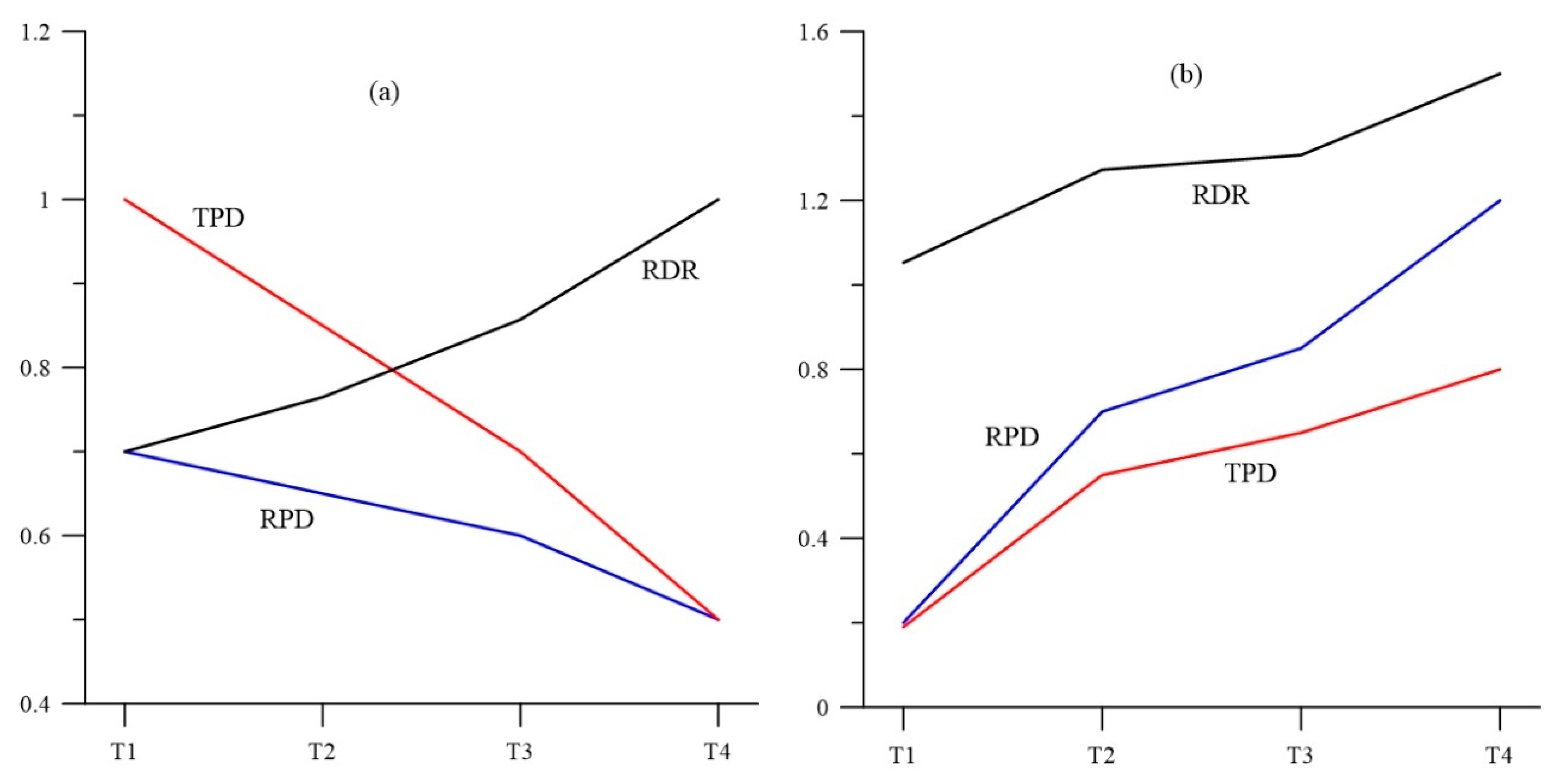
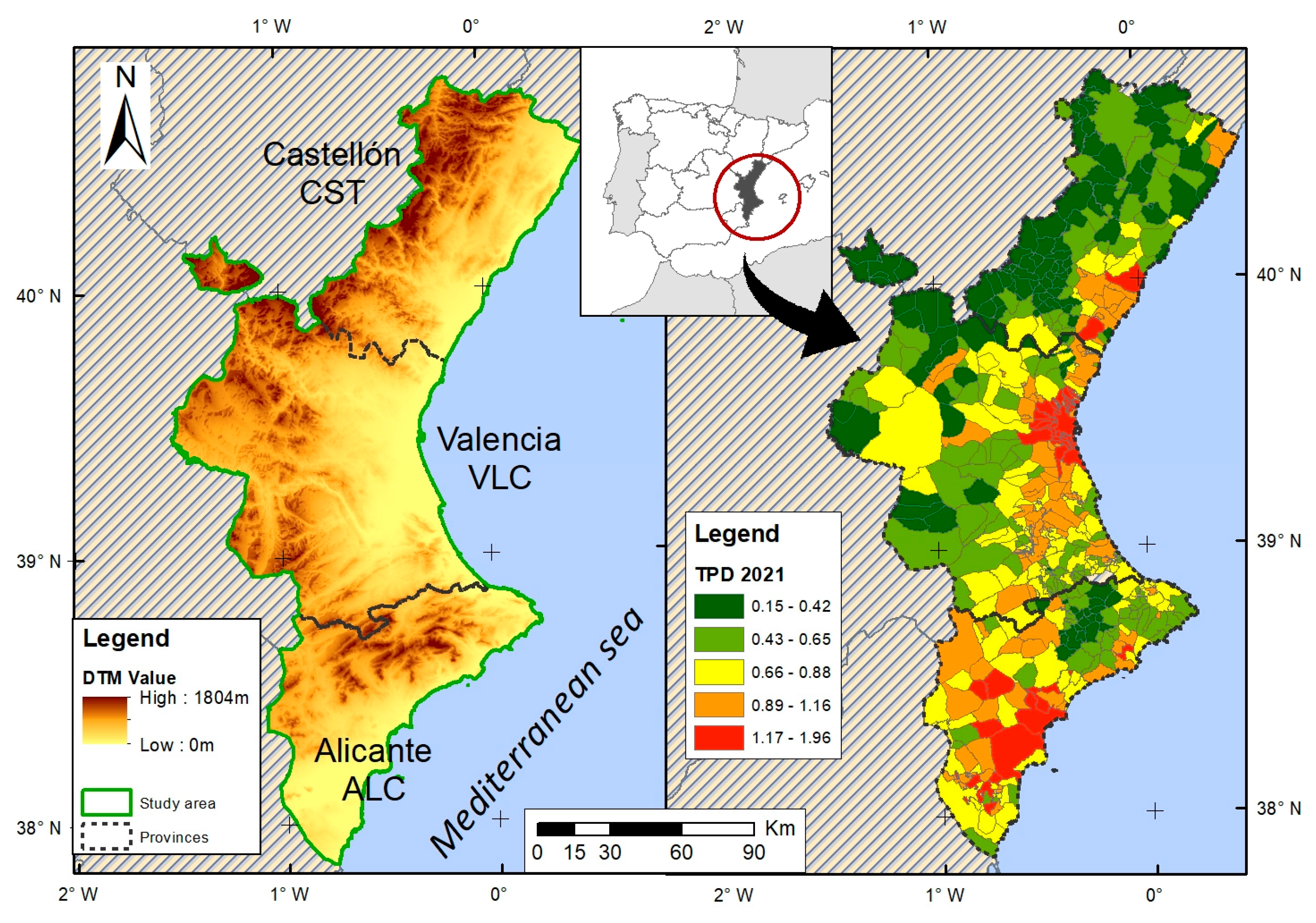


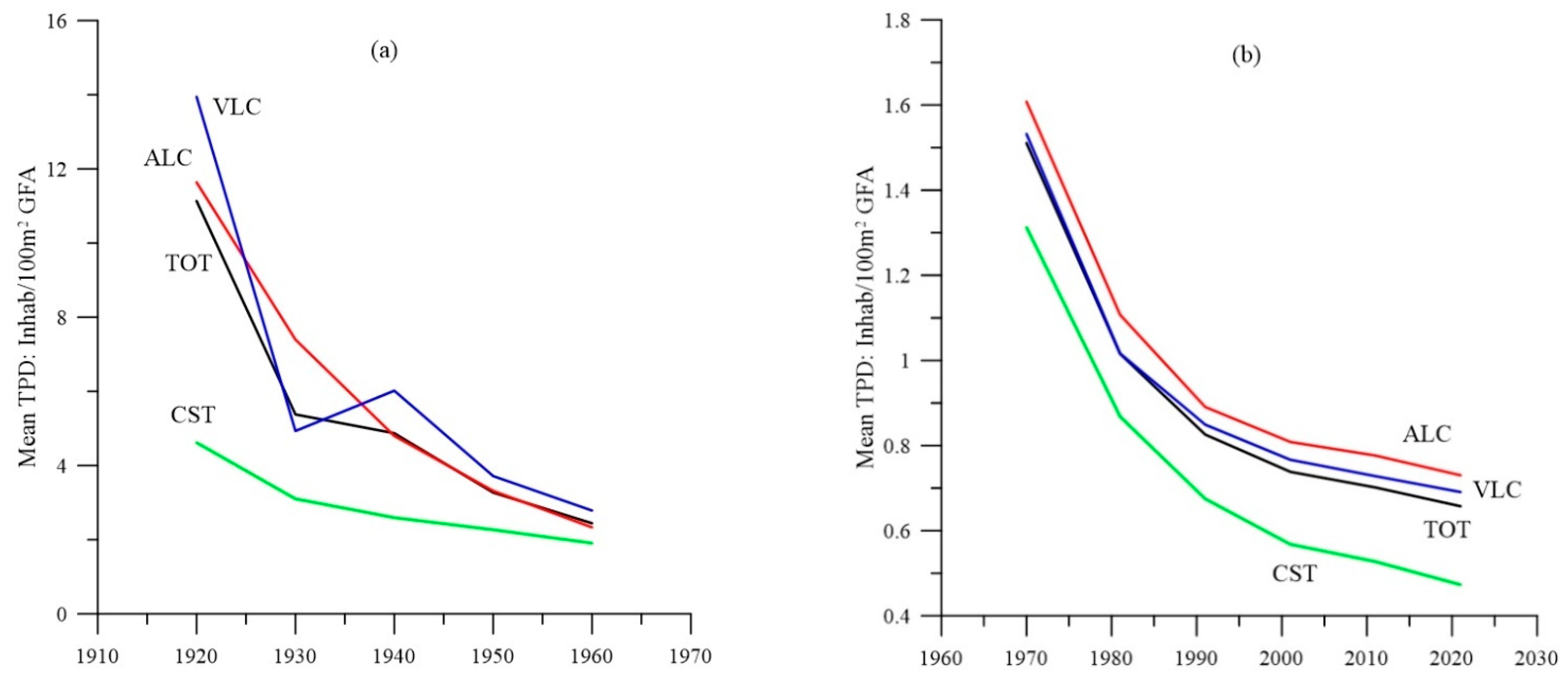
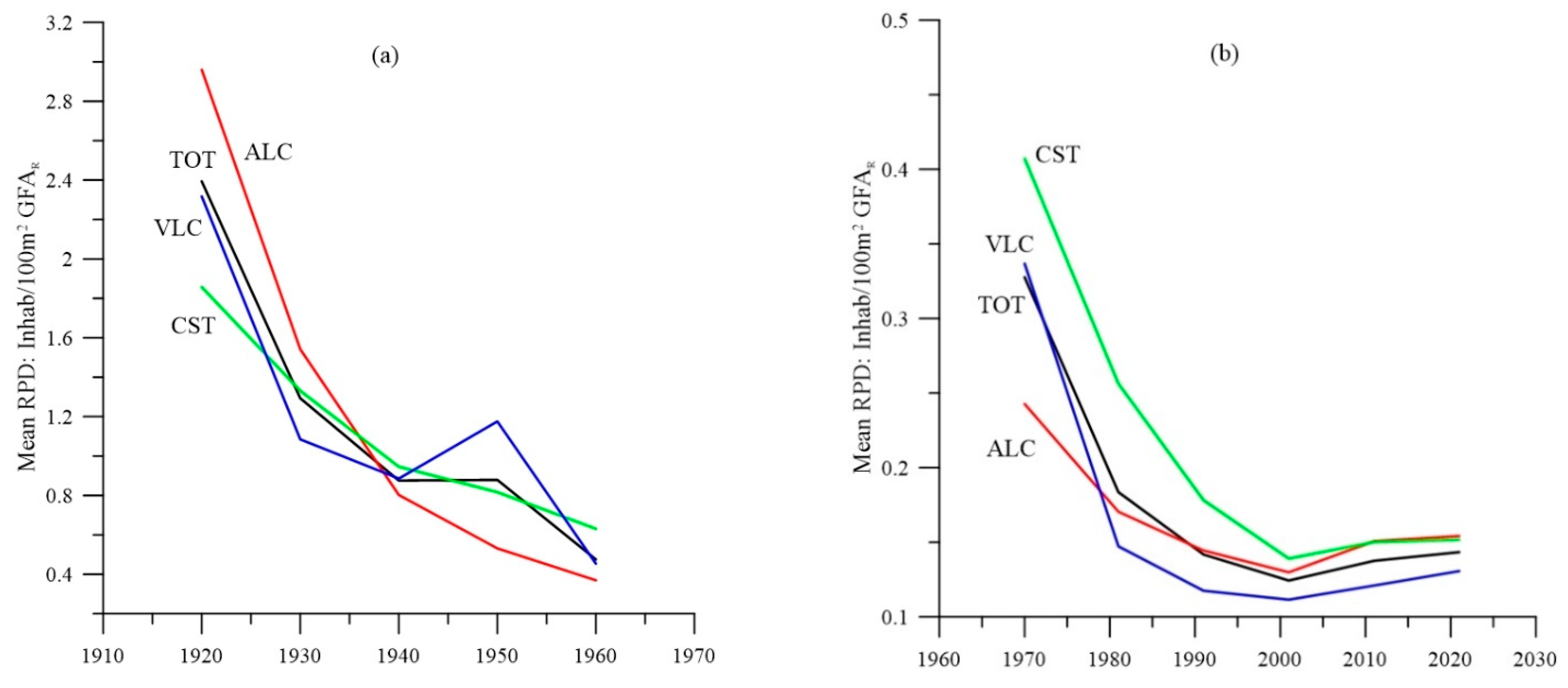

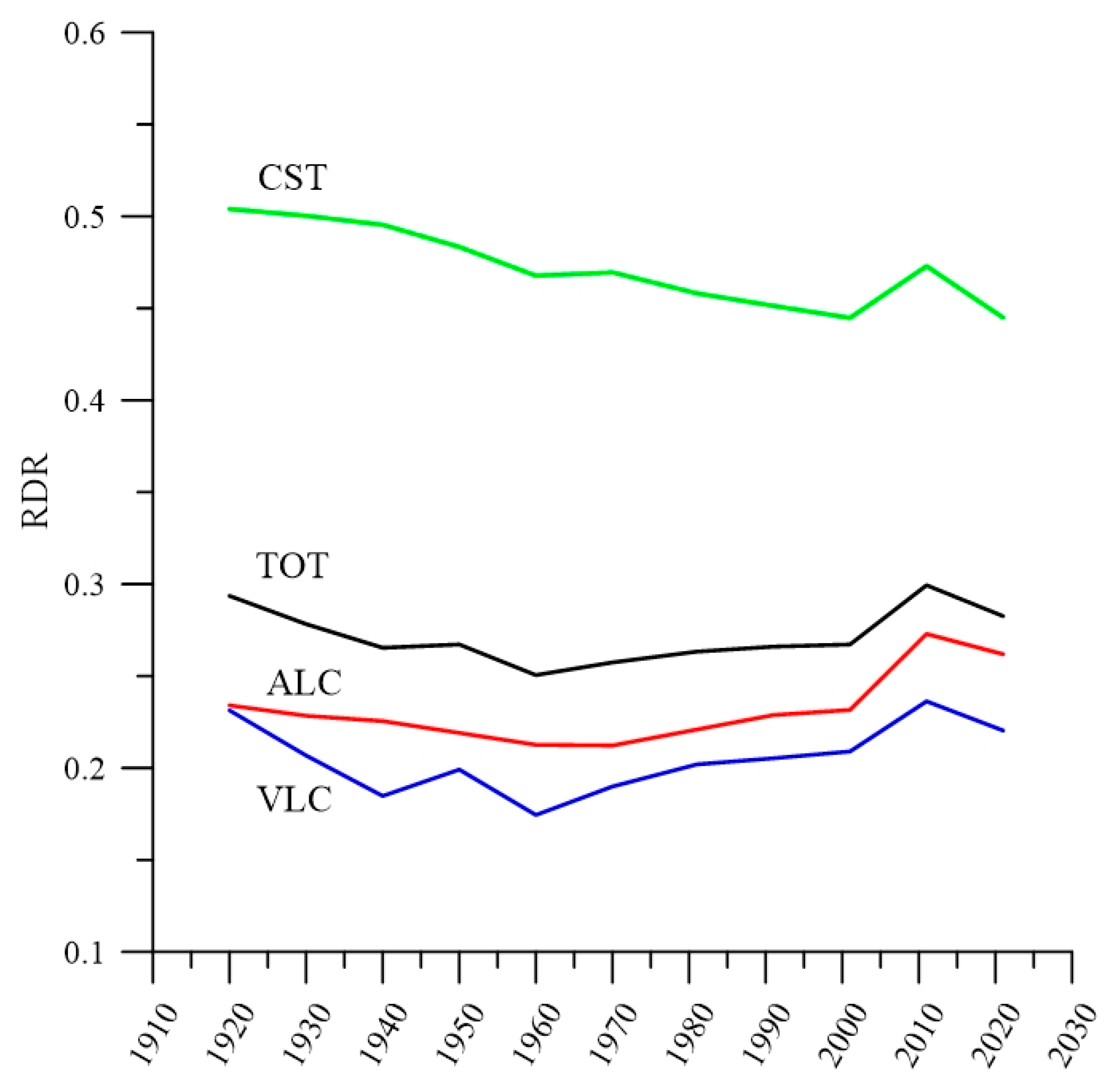
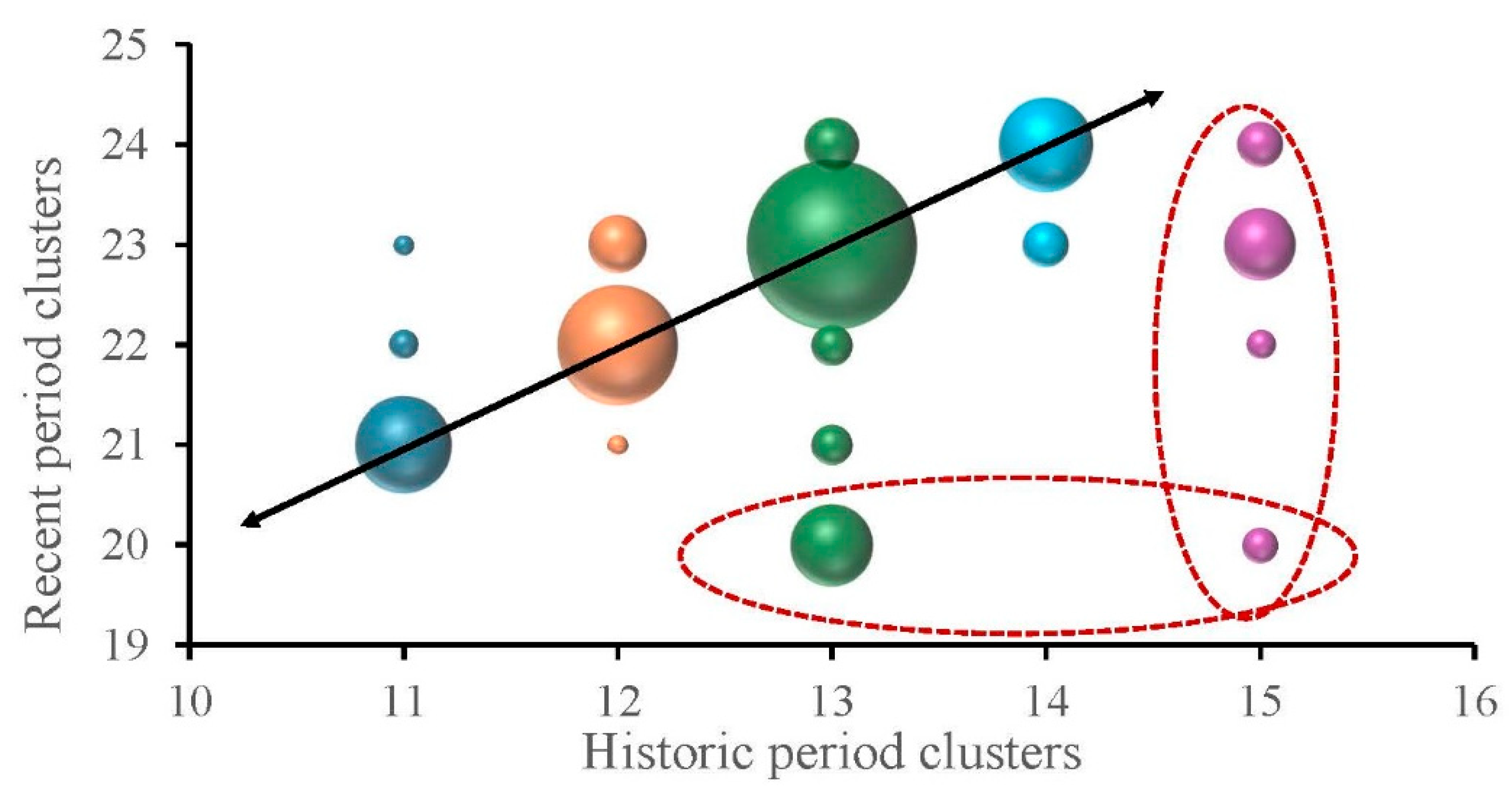

| Acronym | Name | Description |
|---|---|---|
| TPD | Total Population Density | Population density in a UAD |
| RPD | Risk Population Density | Population density in risk area |
| RSR | Risk Surface Ratio | Ratio of built-up area in risk area to total built-up area |
| RPR | Risk Population Ratio | Ratio of affected population to overall population |
| RDR | Risk Density Ratio | Ratio of population density in risk area to overall population density |
| mRDR | RDR slope | Trend value for an RDR time interval |
| RPD60 | RSR60 | RPR60 | RDR60 | mRDR60 | PopT60 | PopR60 | |
|---|---|---|---|---|---|---|---|
| Total | 0.62 | 0.33 | 0.13 | 0.25 | −1.39 | 924,004 | 47,715 |
| ALC | 0.47 | 0.28 | 0.09 | 0.21 | −1.46 | 370,738 | 17,706 |
| CST | 0.87 | 0.49 | 0.28 | 0.47 | −1.73 | 158,473 | 15,741 |
| VLC | 0.62 | 0.28 | 0.08 | 0.17 | −1.17 | 394,793 | 14,268 |
| RPD21 | RSR21 | RPR21 | RDR21 | mRDR21 | PopT21 | PopR21 | |
|---|---|---|---|---|---|---|---|
| Total | 0.16 | 0.34 | 0.13 | 0.29 | 3.71 | 2,416,466 | 62,499 |
| ALC | 0.17 | 0.32 | 0.11 | 0.27 | 6.44 | 1,129,943 | 39,410 |
| CST | 0.19 | 0.49 | 0.28 | 0.46 | −0.23 | 319,097 | 7700 |
| VLC | 0.14 | 0.29 | 0.08 | 0.23 | 3.53 | 967,426 | 15,389 |
| . | RPD60 | RPD 21 | RSR 60 | RSR 21 | RPR 60 | RPR 21 | RDR 60 | RDR 21 | mRDR 60 | mRDR 21 | popR 60 | popR 21 | popT 60 | popT 21 |
|---|---|---|---|---|---|---|---|---|---|---|---|---|---|---|
| RPD60 | 1.00 | |||||||||||||
| RPD21 | 0.24 | 1.00 | ||||||||||||
| RSR60 | 0.06 | 0.13 | 1.00 | |||||||||||
| RSR21 | 0.01 | 0.13 | 0.94 | 1.00 | ||||||||||
| RPR60 | 0.14 | 0.39 | 0.80 | 0.76 | 1.00 | |||||||||
| RPR21 | 0.10 | 0.43 | 0.75 | 0.80 | 0.94 | 1.00 | ||||||||
| RDR60 | 0.27 | 0.42 | 0.57 | 0.51 | 0.83 | 0.75 | 1.00 | |||||||
| RDR21 | 0.22 | 0.72 | 0.50 | 0.54 | 0.78 | 0.83 | 0.78 | 1.00 | ||||||
| mRDR 60 | 0.01 | 0.02 | 0.10 | 0.08 | 0.08 | 0.06 | −0.02 | 0.00 | 1.00 | |||||
| mRDR 21 | −0.16 | 0.24 | −0.13 | 0.02 | −0.15 | 0.05 | −0.30 | 0.14 | −0.03 | 1.00 | ||||
| popR60 | 0.10 | 0.26 | 0.45 | 0.35 | 0.48 | 0.39 | 0.46 | 0.34 | 0.03 | −0.21 | 1.00 | |||
| popR21 | −0.02 | 0.27 | 0.00 | 0.02 | −0.01 | 0.04 | −0.03 | 0.08 | 0.02 | 0.23 | 0.33 | 1.00 | ||
| popT60 | 0.03 | 0.00 | −0.20 | −0.26 | −0.16 | −0.19 | −0.04 | −0.19 | 0.11 | −0.13 | 0.31 | 0.28 | 1.00 | |
| popT21 | 0.00 | −0.06 | −0.33 | −0.37 | −0.24 | −0.25 | −0.16 | −0.29 | 0.12 | −0.08 | 0.07 | 0.32 | 0.76 | 1.00 |
| HP/RPCluster | N° UAD HP/RP | RDR 60 | RDR 21 | mRDR 60 | mRDR 21 | RSR 60 | RSR 21 | PopT 60 | PopT 21 |
|---|---|---|---|---|---|---|---|---|---|
| - -/c20 | - -/43 | - - | 0.34 | -- | 25.4 | - - | 0.25 | - - - | 4345 |
| c11/c21 | 25/27 | 0.76 | 0.78 | 1.2 | 3.0 | 0.96 | 0.88 | 756 | 409 |
| c12/c22 | 43/42 | 0.31 | 0.33 | 2.1 | −0.4 | 0.73 | 0.70 | 1491 | 881 |
| c13/c23 | 118/124 | 0.26 | 0.20 | 4.2 | −1.7 | 0.23 | 0.22 | 5384 | 3943 |
| c14/c24 | 27/44 | 0.18 | 0.16 | 4.1 | 1.9 | 0.12 | 0.10 | 19,964 | 38,467 |
| c15/- - | 26/- - | 0.35 | - - | −42.6 | - - | 0.18 | - - | 2583 | - - - |
| ClsHP | ClsRP | Values | Description |
|---|---|---|---|
| -- | c20 | High mRDR21 | Municipalities with a significant increase in RDR, over-occupation of low-risk areas. The area at risk also increases. |
| c11 | c21 | High RSR High RDR Low population | Very small municipalities located in inland areas, directly affecting the town centre. Higher than average risk. Declining population in the recent series. |
| c12 | c22 | High RSR Medium RDR Low population | Small municipalities. The risk area does not directly or only partially affects the downtown of the most populated town centre. Sharp decline in population. |
| c13 | c23 | Average | Numerous groups of municipalities with medium risk without noteworthy values. |
| c14 | c24 | High population Low RDR Low RSR | Large municipalities. The population is increasing in the recent series, but its RDR is low due to low occupancy in the risk zone. |
| c15 | -- | Low mRDR60 Low RSR | Municipalities with medium population. Decreasing risk trend as construction in affected areas decreases. |
Disclaimer/Publisher’s Note: The statements, opinions and data contained in all publications are solely those of the individual author(s) and contributor(s) and not of MDPI and/or the editor(s). MDPI and/or the editor(s) disclaim responsibility for any injury to people or property resulting from any ideas, methods, instructions or products referred to in the content. |
© 2025 by the authors. Licensee MDPI, Basel, Switzerland. This article is an open access article distributed under the terms and conditions of the Creative Commons Attribution (CC BY) license (https://creativecommons.org/licenses/by/4.0/).
Share and Cite
Cantarino Martí, I.; Gielen, E.; Palencia-Jiménez, J.-S.; Carrión Carmona, M.Á. Population and Landslide Risk Evolution in Long Time Series: Case Study of the Valencian Community (1920–2021). Land 2025, 14, 1148. https://doi.org/10.3390/land14061148
Cantarino Martí I, Gielen E, Palencia-Jiménez J-S, Carrión Carmona MÁ. Population and Landslide Risk Evolution in Long Time Series: Case Study of the Valencian Community (1920–2021). Land. 2025; 14(6):1148. https://doi.org/10.3390/land14061148
Chicago/Turabian StyleCantarino Martí, Isidro, Eric Gielen, José-Sergio Palencia-Jiménez, and Miguel Ángel Carrión Carmona. 2025. "Population and Landslide Risk Evolution in Long Time Series: Case Study of the Valencian Community (1920–2021)" Land 14, no. 6: 1148. https://doi.org/10.3390/land14061148
APA StyleCantarino Martí, I., Gielen, E., Palencia-Jiménez, J.-S., & Carrión Carmona, M. Á. (2025). Population and Landslide Risk Evolution in Long Time Series: Case Study of the Valencian Community (1920–2021). Land, 14(6), 1148. https://doi.org/10.3390/land14061148










